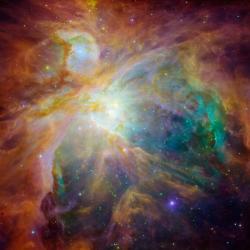Scientists put together an image from photographs of the Orion Nebula at different wavelengths taken by the Hubble and Spitzer Space Telescopes, the joint image brought new insights into the nebula

The joint image, which was composed of photographs taken by two different space telescopes that photograph at separate wavelengths - Spitzer and Hubble, looks like an abstract painting rather than a cosmic photograph. The piece shows the spread of the Orion Nebula, in the infrared, ultraviolet and visible light ranges in between. It is painted with the light of hundreds of young stars on a canvas of gas and dust, using massive ultraviolet light and a strong stellar wind as brushes.
At the heart of the artwork are four massive stars, collectively known as the trapezoid. These stellar beasts are a hundred thousand times brighter than the Sun. Their community is identified in the regular photographs as a yellow spot near the center of the creation. The green swirls were revealed by Hubble's ultraviolet light detector. These are hydrogen and sulfur gases that are heated by enormous ultraviolet radiation coming from the trapezoidal stars. A dash of red and orange are infrared lights discovered by Spitzer that indicate luminous clouds rich in carbon molecules called polycyclic aromatic hydrocarbons. On Earth, these hydrocarbons are found in burnt toasts and car exhaust.
Additional stars in Orion are scattered throughout the image in a variety of colors. Spitzer revealed young stars embedded deep within a shell of dust and gas (orange-yellow dots). Hubble found stars that are less integrated in their greenhouse (green dots) as well as the background stars that are behind or in front of the nebula (in blue). The wind of the stars from the young star clusters moves between the clouds carving different formations in them and creating holes in them.
The Orion Nebula, which is about 1,500 light-years from Earth, is the brightest object in the hunter's sword in the group. The Cosmic Cloud is also the closest star-making factory and astronomers suspect that it has about a thousand young stars. The Orion group is viewable in autumn and winter from northern latitudes. The nebula itself is not visible but can be viewed through binoculars or small telescopes. The image consists of light with wavelengths of 0.43, 0.50 and 0.53 microns in the blue light along with wavelengths of 0.6, 0.65 and 0.91 microns in the green range, 3.6 microns in orange and 8 microns in the red range.
For the news in Universe Today

5 תגובות
Indeed Itzik, you gave a beautiful example, but even these burnt toasts "have a future" because nothing is lost in our universe
They will be caught in a gravitational field that will become a gravitational reactor and they will give their material to build new stars.
Aas is basically part of the universe is burnt toast
There are entire websites whose entire function is to provide images taken by NASA, at the time I was addicted but I don't remember names and I don't have the links anymore….
If it says that an ultraviolet detector emits green light
Surely the colors are synthetic.
What should be done is, bring a picture
Such as a background for a desktop size
1024×768..for those who know the source…..
I understand that the given colors are the colors of the image and not the colors corresponding to the given wavelengths